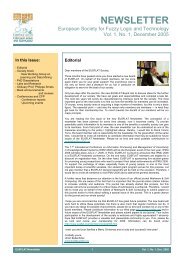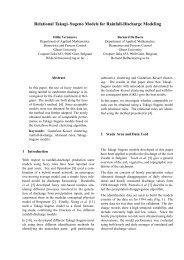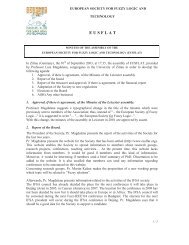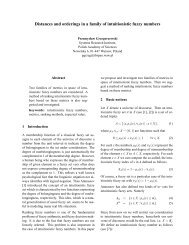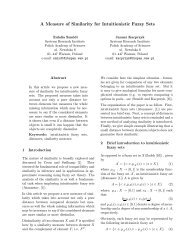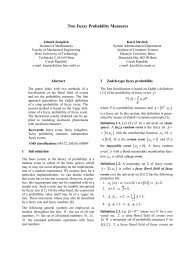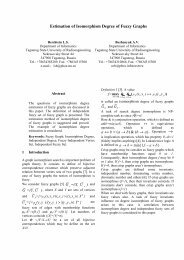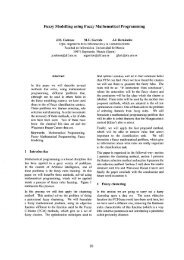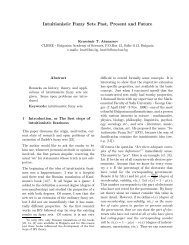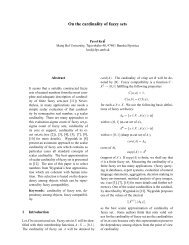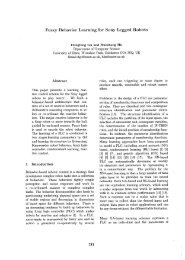Ant Colony Optimization for Distributed Routing ... - ResearchGate
Ant Colony Optimization for Distributed Routing ... - ResearchGate
Ant Colony Optimization for Distributed Routing ... - ResearchGate
Create successful ePaper yourself
Turn your PDF publications into a flip-book with our unique Google optimized e-Paper software.
elatively complex tasks seem to emerge from interactions<br />
between large numbers of ants and their environment. In<br />
some cases, individual ants coordinate their activities using a<br />
principle known as stigmergy [1], whose main characteristics<br />
are: (i) indirect and non-symbolic <strong>for</strong>m of communication<br />
mediated by the environment, that is, ants exchange<br />
in<strong>for</strong>mation by modifying their environment; (ii) stigmergic<br />
in<strong>for</strong>mation is local, which means that it can only be<br />
accessed by ants that visit the immediate vicinity of the place<br />
where it was released.<br />
The communication between individual ants is based on<br />
the use of specific chemicals, called pheromones.<br />
Particularly important <strong>for</strong> the social life of some ant species<br />
is the trail pheromone, which is a specific type of pheromone<br />
they use <strong>for</strong> marking paths on the ground. While walking<br />
between food sources and the nest, ants deposit pheromones<br />
on the ground, <strong>for</strong>ming a pheromone trail. Subsequent ants<br />
sense the pheromone and tend to choose, probabilistically,<br />
paths with a stronger pheromone concentration, further<br />
rein<strong>for</strong>cing it. After some time, ants converge to use a single<br />
shortest path. A compendium of seminal works on the<br />
pheromone trail-laying and trail-following behaviour of some<br />
ant species can be found in [3].<br />
2.2 <strong>Ant</strong> <strong>Colony</strong> <strong>Optimization</strong> <strong>for</strong> Network <strong>Routing</strong><br />
The basic idea underlying ant colony-based algorithms and<br />
systems is to use a <strong>for</strong>m of artificial stigmergy to coordinate<br />
the activities of artificial agents. The majority of ACO<br />
applications have been <strong>for</strong> solving -hard problems, <strong>for</strong><br />
which the best known algorithms that guarantee an optimal<br />
solution have an exponential time worst case complexity. In<br />
some of these problems, ACO algorithms have been shown<br />
to determine high-quality, although not guaranteed to be<br />
optimal, solutions in relatively short time.<br />
The routing problems in telecommunication networks are<br />
particularly interesting <strong>for</strong> ACO, because the intrinsically<br />
distributed nature of ACO can fit well with them. However,<br />
these problems pose additional challenges, because the<br />
routing algorithm should also be able to react rapidly to<br />
changing network and traffic conditions and to maintain<br />
exploration capabilities so that it can effectively evaluate<br />
alternative paths which, in view of the problem dynamics,<br />
can become the best ones at some point in time [1].<br />
The different ACO algorithms <strong>for</strong> network routing have in<br />
common the fact that pheromone tables are stored at the<br />
network nodes and artificial agents, typically in the <strong>for</strong>m of<br />
control packets, are employed to collect node/link state<br />
in<strong>for</strong>mation and update the pheromone tables. ACO was first<br />
applied to network routing in circuit-switched networks, like<br />
the Plain Old Telephone Service (POTS), in [3]. The main<br />
purpose of <strong>Ant</strong>-Based Control (ABC) is to relieve congestion<br />
on the network by preferably routing calls (circuits) via parts<br />
of the network with larger spare capacity, consequently<br />
reducing call blocking probability. Later, ACO was applied<br />
to routing in packet-switched networks, such as IP networks,<br />
in [5]. These networks use store-and-<strong>for</strong>ward nodes, which<br />
contain buffers to store the incoming packets and delay them<br />
until there is free capacity on the preferred output link. With<br />
ISBN: 978-989-95079-6-8<br />
IFSA-EUSFLAT 2009<br />
<strong>Ant</strong>Net [5], an artificial ant is launched at regular intervals of<br />
time from a network node towards another node to discover a<br />
low-cost path between the nodes and to investigate the load<br />
status of the network. The selection of the next node by an<br />
ant is made by assigning to the neighbouring nodes a<br />
probability of being selected that depends not only on the<br />
correspondent pheromone value but also on the occupancy of<br />
the queue associated to the link between the current node and<br />
the neighbouring node. Hence, the chances of selecting a<br />
neighbouring node increase with its pheromone value but<br />
decrease with the queue waiting time associated to it.<br />
ACO has also found application on routing in optical<br />
WDM networks, both in Optical Circuit-Switched (OCS) [6],<br />
[7] and Optical Packet-Switched (OPS) networks [9]. <strong>Ant</strong>Net<br />
was adapted in [9] <strong>for</strong> load balancing in OPS networks. The<br />
nodes of these networks use Fibre Delay Line (FDL) buffers,<br />
which have a very limited contention resolution capability,<br />
when compared to electronic buffers. The proposal modifies<br />
the solution construction phase of the original <strong>Ant</strong>Net<br />
implementation [5] using a suitable expression <strong>for</strong> computing<br />
the buffer occupancy, since FDL buffers behave differently<br />
from electronic buffers.<br />
Despite the recent research activity aiming to use ACO <strong>for</strong><br />
routing in optical WDM networks, both in OCS and OPS, to<br />
the best of the author’s knowledge ACO has not yet been<br />
adapted to the case of OBS networks.<br />
3 Optical burst-switched networks<br />
In current optical transport networks, circuits are established<br />
between nodes during long periods of time (weeks, months)<br />
using wavelength channels with a capacity of several Gbit/s<br />
each. However, the dominant IP packet traffic carried over<br />
these networks significantly fluctuates over relatively small<br />
time scales. Hence, current circuit-switched optical networks<br />
are inefficient to support this type of traffic due to both their<br />
coarse granularity and slow circuit setup time. OPS networks<br />
would provide the best adaptation between the IP traffic and<br />
the optical network resources used, but they cannot be<br />
implemented with state-of-the-art technology, namely due to<br />
the already referred lack of efficient optical buffers. OBS<br />
networks have attracted considerable interest because their<br />
switching granularity and optical technology complexity are<br />
in between those of OCS and OPS [10].<br />
3.1 Network Architecture<br />
At the ingress edge nodes of OBS networks, IP packets are<br />
assembled into large chunks of data, called bursts. Each data<br />
burst is transmitted using a wavelength channel and must be<br />
switched at the core nodes until it reaches the egress edge<br />
node, where it is disassembled and its packets delivered to<br />
the local IP network. Resource reservation <strong>for</strong> each burst is<br />
made using a control message, known as Burst Header<br />
Packet (BHP), sent ahead of the data burst on a separate<br />
wavelength channel. Each node along the routing path of the<br />
burst processes the BHP and configures its switching matrix<br />
to direct the upcoming data burst to an available wavelength<br />
channel on the appropriate output fibre link. The interested<br />
reader can find more in<strong>for</strong>mation on OBS networks in [10].<br />
179



